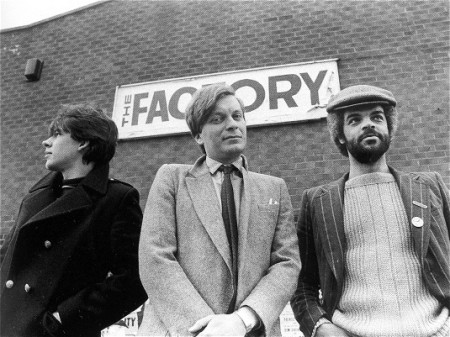On November 22, 1992, Factory Records was finally declared bankrupt, ending one of the most fascinating stories in British music. Here we take a run through the rise and fall of the legendary label and the people behind it.
In 1973 Tony Wilson, a Manchester born Cambridge graduate, returned to his home city to persue a career in journalism. He took a job as a reporter with Manchester’s independent station Granada Television and became known for his ‘Kamikaze Corner’ in which he would undertake various stunts for the public’s viewing pleasure, including a stab at Hang-gliding which was later recreated in the 2002 film 24 Hour Party People.
In July 1976, Wilson was given the chance to combine a burning passion for music with his television career when he landed the presenter’s job for a new Granada music and culture programme entitled So It Goes. Brought in to rival the BBC’s established music vehicles Top Of The Pops and The Old Grey Whistle Test, the show gave Wilson the platform to premiere a clutch of new bands who were emerging from the burgeoning punk scene, a scene which Wilson himself had fallen in love with.
This love affair started in earnest just a month before So It Goes hit the airwaves for the first time, when Wilson had been present at the Sex Pistols‘ now legendary gig at Manchester’s Lesser Free Trade Hall. Tony subsequently gave the band their television debut on his show, and also introduced the likes of Iggy Pop, Blondie, Patti Smith and The Jam to the north of England.
Not content with merely giving bands their big break on TV, Wilson soon took his musical interest one step further when he began managing a small group of local bands such as A Certain Ratio with his friend Alan Erasmus, who at the time was a jobbing actor who had landed a few small roles in programmes such as the long-running soap Coronation Street.
It was in his new found status as ‘Manager’ that Tony Wilson visited the Stiff-Chiswick challenge at the Rafter’s club in April 1978. Amongst the acts playing that night were Joy Division, a four-piece led by an enigmatic frontman by the name of Ian Curtis. Said to be angered at being last on the bill, the band delivered a blistering performance which captivated Wilson. Rob Gretton, a DJ at the club that night, was just as enraptured and immediately approached Joy Division with an offer to become their manager; soon, Gretton would become a partner and leading player in Factory too.
The next step for Tony Wilson was to find a venue which would allow him to showcase his own bands, as well as other groups slowly emerging from the North West of England. Eventually, Wilson and Erasmus settled on a venue called The Russel Club in the otherwise unappealing Moss Side area of Manchester. They were given a Friday night spot and the club, on the suggestion of Erasmus, became known as The Factory on those Fridays. It was to promote this new club night that Wilson and Erasmus first enlisted the talents of Peter Saville, an art student whose subsequent art designs for Factory would become almost as legendary as the bands themselves.
Further strides were made by Wilson and Erasmus when they began to independently release recordings on vinyl. They approached Joy Division with an opportunity to work with producer Martin Hannett (who would go on to produce most of Factory’s bands). A contract, in its loosest possible form, was famously signed in Wilson’s blood. It was a deal which stipulated Wilson would not own any of the group’s work, would offer entire creative freedom and would split all profits 50/50. This became the template for all of their future signings and instantly marked Factory out as unique in the music industry.
In December 1978, Joy Division were included along with the Duritti Column, John Dowie and Cabaret Voltaire on the EP ‘A Factory Sample‘ – the first official recording released by Factory Records. As such, the EP was labelled ‘FAC2’ (Peter Saville’s poster for their first club night at The Russel Club being ‘FAC1’) – a chronological trend Factory continued throughout the coming years.
In April 1979, Joy Division turned down offers from major labels to record their debut album with Factory. ‘Unknown Pleasures‘ (FAC10) was Factory’s first album issue, and was released in June 1979. Hailed by critics, although only enjoying limited commercial success it gained both Joy Division and Factory Records a dedicated following. After the album’s release, the band enjoyed a steady rise in popularity and laid down their seminal hit ‘Love Will Tear Us Apart‘ in March 1980. By the time that classic had been released, Factory’s care-free, hedonistic lifestyle had been hit with tragedy.
After finishing sessions for their second album ‘Closer‘, Joy Division were celebrating the news that they were to tour the US for the first time – it was a tour they would never begin. On the morning of 18th May 1980, the night before they were due to fly to the US, Ian Curtis – who had been battling severe epilepsy and was said to be having problems with his marriage – was found dead in the kitchen of his home in Macclesfield. He was just 23 years old.

the legendary, but hugely expensive, sleeve for ‘blue monday’
After much soul-searching following Curtis’ death, the remaining members of Joy Division, as well as Factory, would grow stronger and go on to enjoy increased popularity in the following years. Out of the ashes of Joy Division, Bernard Sumner, Peter Hook and Stephen Morris, along with Gillian Gilbert, re-emerged as New Order.
Several trips to New York later, the band began to combine their guitar roots with a new dance scene which was growing in the Big Apple, and soon New Order was taking a markedly different approach to its predecessor. After releasing their debut album ‘Movement‘ in November 1981, they handed Factory their biggest hit to date when ‘Blue Monday‘ hit the shelves in March 1983.
The track went on to become the biggest selling 12″ single of all time but, as ever, Factory failed to gain from its runaway success. The label made a huge loss thanks to the brilliant but hugely expensive sleeve, designed to look like a floppy disk, which was so costly to make that the label was undercut on every copy they sold.
With the Factory partners looking for a new money making venture, and with a desire to move on from the tragedy of Ian Curtis’ suicide, the idea was mooted by Rob Gretton to open a new, bigger nightclub in Manchester as a permanent home for the enterprise. Inspired by the clubs Wilson had visited with New Order on their trips to New York, on 21st May 1982 the Hacienda (FAC51) – a converted sales room in the city centre – opened its doors for the first time…and was initially met by a lukewarm response.
The radical new design was a world away from what anyone in Britain had seen before, and in all-too familiar fashion, the club was making losses of up to £50,000 a month in its early years. Eventually though, as the new dance and rave music championed by the Hacienda steadily grew in popularity, the club became a mecca for the new religion and its disciples. Its significance to an entire generation was cemented, as was the legacy of Factory.
Many of the best emerging bands of the time, including The Smiths, played live at the Hacienda, and in 1985 the club staged a ‘Battle Of The Bands’ contest in a bid to discover more new acts in the region. Playing that night were a young group going by the name of the Happy Mondays who, despite a fairly shambolic performance, won the affection of Tony Wilson. They were soon signed to Factory, and marked a departure from the brand of artists which the label had generally gravitated towards in the past.
Indeed, the Happy Mondays became a symbol and driving force for the Hacienda-era of Factory, and were far removed from the new wave, even art-leaning bands which had been led by Joy Division a few years earlier. Again, Factory threw seemingly endless amounts of money at their new pet, and by 1989 the Happy Mondays were enjoying a level of success only rivalled on Factory by New Order, who that year were busy releasing their classic UK number one album ‘Technique‘.
The Mondays were the true anti-heroes of the Hacienda revellers they were so inextricably linked to, and married their rock roots with dance to become the soundtrack to what was now the most talked about nightclub in Britain. In 1988 the Hacienda was the centre of the so-called Second Summer Of Love and Manchester had a new name – ‘Madchester’.
With the popularity of its three main torch-carriers – New Order, the Happy Mondays and the Hacienda – Factory was finally making profit. This wouldn’t last long however, and soon the habit of leaking money returned. In the case of New Order, they were still finding much of their royalties being pumped back into the Hacienda and, as partners, they found their profits largely reliant on the fluctuating fortunes of the club.
As for the Happy Mondays, the heady success of 1990’s ‘Pills ‘n’ Thrills and Bellyaches‘ and its defining single ‘Step On‘ marked the loss of any degree of musical focus. Faced with a band engulfed in drug addiction, and desperate for a new album, Factory paid for the Happy Mondays to record new material in Barbados. It was a flawed plan, and the band blew almost their entire budget on drugs and returned home with just a handful of scratchy recordings. By the time the resultant album ‘Yes, Please‘ was finally released in 1992, grunge had arrived, interest had shifted from Manchester to Seattle, and Factory failed to get the hit album they so desperately needed.
Alongside the huge losses being made by its two principal bands, Factory also began to hemorrhage money from the Hacienda once again. After the peak of the summer of ’88, the club began to be infiltrated by gang members. With robberies and gun crime in and around the premises now common place, the club was forced to shut for the first time in January 1991. It reopened a few months later with increased security measures, but when trouble erupted inside not long after, the police moved in once more; it was clear the spirit and beating heart of the club had been lost forever.
With money leaking from every orifice by the end of 1992, it was of no surprise when Factory went into receivership in the November of that year. Its label was sold to London Records for a tiny amount when the terms of Wilson’s original agreement with Joy Division over a decade earlier were discovered.
As for the Hacienda, it struggled on for another five years, but eventually closed its doors for the last time in the summer of 1997, bringing to an end the amazing ‘social experiment’ which was Factory. In the current climate of major record labels and huge budgets, it’s hard to imagine a record label that had no accountants, no press, and which wouldn’t concern itself with anything as tedious as promoting records.
Ultimately, the business was inevitably going to end in financial ruin – little wonder that the recent biography released by Joy Division/New Order bassist Peter Hook is called The Hacienda – How Not To Run a Club.
To dwell on the business failures is to entirely miss the point of Factory however. They combined music, art and culture to create the last significant youth movement of the 20th century, and brought inspiration to countless new bands. In an age when any guitar band can be labelled ‘indie’, Factory Records remains a symbol of real musical independence, and of what can be achieved by remaining true to those ideals.
As Tony Wilson himself said: “All that was valuable was the history we made, not the money we made.”
(Dave Smith)




